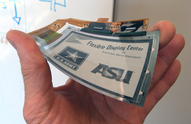
|
|
|

The research made by the Korean team was first published in the journal Nature Communications
|
Can you think of a computer that is paper-thin, and can be rolled up like paper? If the recent news about the recent breakthrough by Korean scientists are to be believed, we will soon be working with ultra-light and ultra-thin computers, instead of the heavy laptops and notebooks. The scientists have developed highly flexible organic light-emitting diodes (OLEDs), which have excellent efficiency. The use of graphene will make transparent electrode fairly possible. Incidentally, OLEDs, built upon a plastic substrate, have received quite some attention of late for their use in next-generation displays that can be bent or rolled while still operating.

A team lead by Seunghyup Yoo from Korea Advanced Institute of Science and Tae-Woo Lee from Pohang University of Science and Technology in South Korea used graphene as a transparent electrode (TE) which is placed in between titanium dioxide (TiO2) and conducting polymer layers. This is an optical design that induces a synergistic collaboration between the high-n and low-n layers to increase the effective reflectance of TEs. Under this approach, graphene-based OLED devices remain intact, and can operate even after 1000 bending cycles at a radius of curvature as small as 2.3 mm.

"We expect that our technology will pave the way to develop an OLED light source for highly flexible and wearable displays, or flexible sensors that can be attached to the human body for health monitoring, for instance," Lee said.
The research made by the Korean team was first published in the journal Nature Communications
0 Comments
Leave a Reply. |
Get Updates Via EmailBlog SponsorsCategory
All
Archives
January 2019
|
|
|
Contact UsEmail: [email protected]
Stay Connected |
Download Our Mobile App |